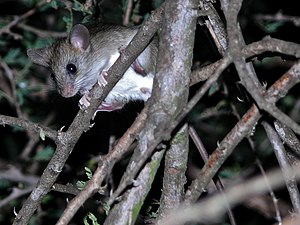Acacia mice
| Acacia mice | ||||||||||||
|---|---|---|---|---|---|---|---|---|---|---|---|---|

Grammomys dolichurus |
||||||||||||
| Systematics | ||||||||||||
|
||||||||||||
| Scientific name | ||||||||||||
| Grammomys | ||||||||||||
| Thomas , 1915 |
The acacia mice ( Grammomys ), also known as African bush mice , are a genus of long-tailed mice that is exclusively native to Africa .
General
These slender mice weigh between 18 and 65 grams, the head-trunk length is about 9.7 to 14 centimeters, the tail is 14 to 20 centimeters long and hairy at the tip. The color varies on top between reddish-brown to yellowish. The white bottom is clearly set off from the top. Externally, the acacia mice can be distinguished from the rather similar thicket rats by their relatively longer tail, narrow hind feet and mostly paler basic color.
Three species investigated so far ( G. rutilans , G. cometes , G. dolichurus ) inhabit high grass areas, moist forests and areas with secondary vegetation . All three are nocturnal and arboreal. The nests are located in tree holes, buildings or plant balls at a height of 0.5 to 4 meters above the ground. The species Grammomys dolichurus has become an important laboratory animal in malaria research and is therefore relatively well researched. It feeds mainly on green stalks, fruits, nuts, flowers and other plant components, but also eats insects. This species lives solitary. The female gives birth to a litter with usually two to four young every 5 to 6 weeks, especially in the wet months.
Systematics
The acacia mice were often only regarded as a subgenus of the thicket rats ( Thamnomys ). Studies of mitochondrial DNA, on the other hand, bring them into direct proximity to the African bush rats ( Aethomys ). Wilson & Reeder (2005) assign them to the Oenomys group . According to genetic studies by Lecompte et al. (2008) they are part of a predominantly African radiation of old world mice, which are summarized as Arvicanthini.
Wilson & Reeder (2005) distinguish the following twelve types:
- Grammomys aridulus is only known from one site in western Sudan.
- Grammomys buntingi is a very rare species found from Senegal to Ivory Coast.
- Grammomys caniceps lives on the coast of Somalia and Kenya.
- Grammomys cometes occurs in eastern Zimbabwe, southern Mozambique and northeastern South Africa.
- Grammomys dolichurus occurs in eastern Africa from Sudan to South Africa.
- Grammomys dryas lives in the Ruwenzori and Kivu area in the east of the Democratic Republic of the Congo, Uganda and Burundi.
- Grammomys gigas only lives in the area of Mount Kenya in Kenya.
- Grammomys ibeanus is distributed along the East African Rift Valley from southern Sudan to Malawi.
- Grammomys kuru lives in the Congo Basin from the Central African Republic to Uganda.
- Grammomys macmillani has a fragmentary occurrence from Sudan to Tanzania, the species may also live in western Africa.
- Grammomys minnae is endemic to Ethiopia.
- Grammomys poensis is common in western Africa from Guinea to Angola.
G. kuru and G. poensis are often combined into one species. However, the previous name for this species, G. rutilans , is invalid.
The IUCN lists G. gigas as "high risk" ( endangered ), G. minnae as "at risk" ( vulnerable ) and G. dryas as "low risk" ( near threatened ). For G. aridulus , G. buntingi and G. caniceps “too little data is available” ( data deficient ), the other species are “not endangered” ( least concern ).
literature
- Ronald M. Nowak: Walker's Mammals of the World. 2 volumes. 6th edition. Johns Hopkins University Press, Baltimore MD et al. 1999, ISBN 0-8018-5789-9 .
- Don E. Wilson , DeeAnn M. Reeder (Eds.): Mammal Species of the World. A taxonomic and geographic Reference. 2 volumes. 3. Edition. Johns Hopkins University Press, Baltimore MD 2005, ISBN 0-8018-8221-4 .
- Emilie Lecompte, Ken Aplin, Christiane Denys, François Catzeflis, Marion Chades, Pascale Chevret: Phylogeny and biogeography of African Murinae based on mitochondrial and nuclear gene sequences, with a new tribal classification of the subfamily. In: BMC Evolutionary Biology. Vol. 8, 199, 2008, pp. 1-21, doi : 10.1186 / 1471-2148-8-199 .